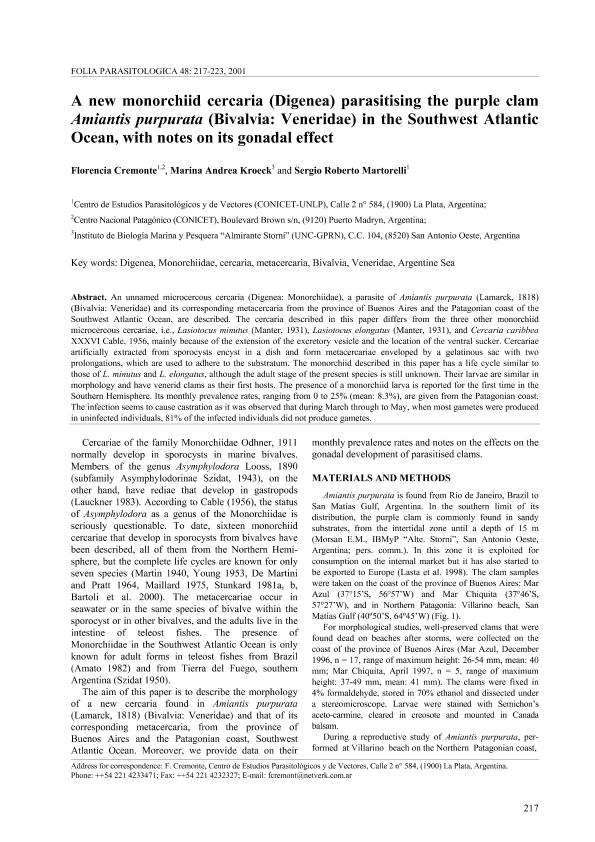Artículo
A new monorchiid cercaria (Digenea) parasitising the purple clam Amiantis purpurata (Bivalvia: Veneridae) in the Southwest Atlantic Ocean, with notes on its gonadal effect
Fecha de publicación:
12/2001
Editorial:
Folia Parasitologica
Revista:
Folia Parasitologica
ISSN:
0015-5683
Idioma:
Inglés
Tipo de recurso:
Artículo publicado
Clasificación temática:
Resumen
An unnamed microcercous cercaria (Digenea: Monorchiidae), a parasite of Amiantis purpurata (Lamarck, 1818) (Bivalvia: Veneridae) and its corresponding metacercaria from the province of Buenos Aires and the Patagonian coast of the Southwest Atlantic Ocean, are described. The cercaria described in this paper differs from the three other monorchiid microcercous cercariae, i.e., Lasiotocus minutus (Manter, 1931), Lasiotocus elongatus (Manter, 1931), and Cercaria caribbea XXXVI Cable, 1956, mainly because of the extension of the excretory vesicle and the location of the ventral sucker. Cercariae artificially extracted from sporocysts encyst in a dish and form metacercariae enveloped by a gelatinous sac with two prolongations, which are used to adhere to the substratum. The monorchiid described in this paper has a life cycle similar to those of L. minutus and L. elongatus, although the adult stage of the present species is still unknown. Their larvae are similar in morphology and have venerid clams as their first hosts. The presence of a monorchiid larva is reported for the first time in the Southern Hemisphere. Its monthly prevalence rates, ranging from 0 to 25% (mean: 8.3%), are given from the Patagonian coast. The infection seems to cause castration as it was observed that during March through to May, when most gametes were produced in uninfected individuals, 81% of the infected individuals did not produce gametes.
Palabras clave:
ARGENTINE SEA
,
BIVALVIA
,
CERCARIA
,
DIGENEA
,
METACERCARIA
,
MONORCHIIDAE
,
VENERIDAE
Archivos asociados
Licencia
Identificadores
Colecciones
Articulos(CCT-CENPAT)
Articulos de CTRO.CIENTIFICO TECNOL.CONICET - CENPAT
Articulos de CTRO.CIENTIFICO TECNOL.CONICET - CENPAT
Articulos(CEPAVE)
Articulos de CENTRO DE EST.PARASITOL.Y DE VECTORES (I)
Articulos de CENTRO DE EST.PARASITOL.Y DE VECTORES (I)
Citación
Cremonte, Florencia; Kroeck, Marina Andrea; Martorelli, Sergio Roberto; A new monorchiid cercaria (Digenea) parasitising the purple clam Amiantis purpurata (Bivalvia: Veneridae) in the Southwest Atlantic Ocean, with notes on its gonadal effect; Folia Parasitologica; Folia Parasitologica; 48; 3; 12-2001; 217-223
Compartir
Altmétricas




